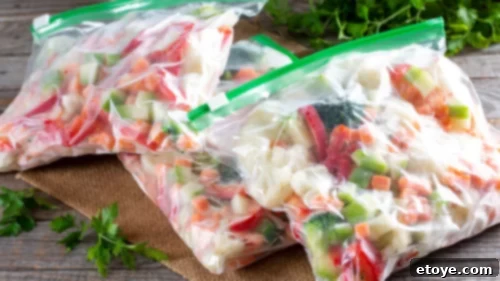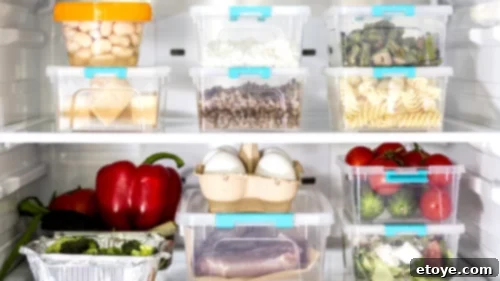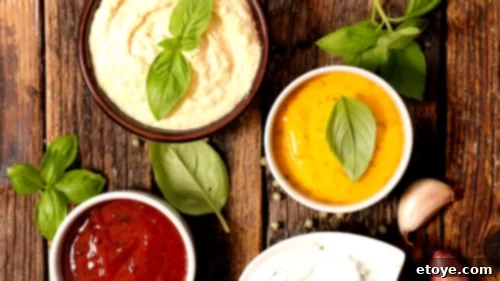In today’s economic climate, where prices seem to climb relentlessly and our hard-earned money stretches less than ever before, finding clever ways to save and optimize our resources is crucial. The rising cost of groceries, in particular, has many of us feeling the pinch and experiencing “sticker shock” with every visit to the supermarket. Beyond the initial purchase, the unfortunate reality of food waste further exacerbates the problem, with perfectly good ingredients often spoiling before they can be used, effectively throwing money straight into the bin.
But what if there were simple, actionable strategies you could implement right in your kitchen to combat both soaring costs and unnecessary waste? What if you could transform your daily cooking habits into a more efficient, budget-friendly, and sustainable routine? After navigating the challenges of a tightening budget and the frustration of discarding unused food, I discovered that smart kitchen solutions are not just helpful but essential. These practical tips have made a significant difference for me, and I believe they can empower you to save money and dramatically reduce food waste in your household too. Here are 5 impactful kitchen tips designed to help you cook smarter, save more, and embrace a more sustainable approach to food.
#1 – Master Your Mornings: Prep & Freeze Smoothie Fruits & Veggies

Smoothies are a fantastic way to kickstart your day, packed with nutrients, vitamins, and the potential for a protein boost. They are especially convenient for busy mornings or post-workout refueling when you need a quick, healthy meal. However, a common pitfall for many smoothie enthusiasts is the struggle to use all fresh produce before it spoils. We’ve all been there: buying a vibrant array of fruits and vegetables with the best intentions, only to find some wilting or softening in the fridge a few days later. This cycle of purchase, partial use, and discard is not only frustrating but also a significant contributor to food waste and a drain on your grocery budget.
The solution is wonderfully simple and incredibly effective: prep and freeze your smoothie ingredients! Instead of reaching for individual fresh items each morning, dedicate a short amount of time once a week to prepare your produce. Begin by thoroughly washing all your fruits and vegetables. Then, chop them into smoothie-ready pieces. For instance, slice bananas, dice mangoes and pineapples, chop leafy greens like spinach or kale, and quarter berries. Once prepped, portion these ingredients into individual freezer-safe bags or containers. You can create custom blends for each day, or simply freeze single ingredients separately and mix and match later.
Imagine the ease of your morning routine: simply grab a pre-portioned bag of frozen fruit and veggies from the freezer, toss it into your blender, add your liquid of choice (dairy milk, plant-based milk, or juice), and any protein powder or supplements. In moments, you have a delicious, nutritious smoothie, with zero last-minute chopping or decision fatigue. This method not only drastically cuts down on food waste by preserving your produce at its peak but also saves valuable time during those hectic weekday mornings. It ensures you’re consistently getting your daily dose of fruits and vegetables, making healthy eating both convenient and economical. Plus, reusing your freezer baggies each week adds another layer of eco-friendliness to this smart kitchen habit.
#2 – Rescue & Rejuvenate: Freeze Those Overripe Bananas!

Bananas are a household staple, a versatile fruit loved for its natural sweetness and potassium content. Yet, they are also one of the most frequently wasted items in our kitchens. How many times have you bought a bunch of bananas with grand plans, only to watch them transform from vibrant yellow to speckled brown, eventually becoming a soft, mushy mess? The sight of overly ripe bananas often leads to a sense of regret and, more often than not, they end up in the trash. This common scenario highlights a missed opportunity for delicious baking and a preventable source of food waste.
Before you toss those brown bananas, stop! Overripe bananas are not a sign of spoilage, but rather a culinary gift. As bananas ripen, their starch converts to sugar, making them incredibly sweet and moist – ideal for a wide array of baked goods. Freezing them is the perfect way to preserve this natural sweetness and ensure they’re always on hand for your next baking adventure. Simply peel the bananas, break them into a few pieces (or slice them if you prefer), and place them in a freezer-safe bag or container. They can be stored for several months, ready whenever your sweet tooth calls.
The versatility of frozen overripe bananas is remarkable. They are the secret ingredient to the most flavorful and moist banana bread and muffins, adding a depth of sweetness and a tender crumb that underripe bananas simply can’t achieve. Beyond the classics, consider blending them into “nice cream” – a dairy-free, guilt-free ice cream alternative. They can also be incorporated into pancake or waffle batter for a naturally sweet breakfast, mashed into oatmeal for extra flavor, or even used to make delectable banana cookies or fritters. For smoothies, frozen bananas add a creamy texture and natural sweetness, eliminating the need for added sugars. By embracing the simple act of freezing overripe bananas, you not only eliminate food waste but also unlock a world of delicious, budget-friendly possibilities for sweet treats and healthy meals. It’s a simple hack that transforms a potential discard into a valuable ingredient, adding both flavor and savings to your kitchen.
#3 – Smart Storage Solutions: Optimize Food Preservation & Reduce Waste

One of the most impactful ways to combat food waste and significantly trim your grocery budget is by extending the shelf life of your food items. Proper storage isn’t just about keeping things fresh; it’s about optimizing their environment to maintain quality, flavor, and nutritional value for as long as possible. While we often focus on fruits and vegetables, which have specific requirements for refrigeration, humidity, and airflow, the principles of optimal storage apply to nearly everything in your pantry and fridge, preventing premature spoilage and ensuring you get the most out of every purchase.
Let’s consider brown sugar, a notorious culprit for becoming rock-hard and unusable. This happens when moisture evaporates, turning the soft, pliable sugar into a solid brick. But this common kitchen frustration is easily avoidable! By simply tossing a small piece of orange peel, an apple slice, or even a couple of marshmallows into an airtight container of brown sugar, you can keep it soft and fresh for weeks. These items release moisture, preventing the sugar from hardening. If you’ve already found yourself with a sugar brick that “could double as an anchor,” fear not! A quick fix is to place the hardened sugar in a microwave-safe bowl next to a small glass of water and microwave it for 20-30 seconds. The steam from the water will reintroduce moisture, softening the sugar with ease.
Beyond brown sugar, a few general storage principles can make a huge difference:
- Herbs: Treat fresh herbs like a bouquet of flowers. Trim the stems, place them in a glass of water, cover loosely with a plastic bag, and refrigerate. They’ll stay fresh for much longer.
- Berries: To prevent mold, give berries a quick vinegar wash (1 part white vinegar to 3 parts water), rinse thoroughly, and then dry them completely before storing them in a breathable container in the fridge.
- Onions & Potatoes: Store these in a cool, dark, and dry place, but keep them separate. Potatoes release moisture and ethylene gas, which can cause onions to sprout and spoil faster.
- Bread: For longer preservation, slice and freeze bread. You can pull out individual slices as needed for toast without thawing the entire loaf.
- Dairy & Eggs: Store eggs in their original carton on a middle shelf in the fridge, not the door, where temperature fluctuations are common. Ensure dairy products are always sealed tightly.
- Airtight Containers: For almost all opened dry goods (flour, sugar, pasta, cereal), transferring them to airtight containers protects them from moisture, pests, and staleness, extending their usability.
By implementing these smart storage hacks, you empower yourself to significantly reduce food waste, save money by making ingredients last longer, and ensure your kitchen is stocked with fresh, ready-to-use items. It’s a small change with a huge impact on your grocery bill and your commitment to a more sustainable kitchen.
#4 – Reinvent & Relish: Fall in Love with Your Leftovers!

Leftovers often get a bad rap. The thought of eating the same meal two or three nights in a row can quickly lead to culinary boredom, resulting in perfectly good food being forgotten in the back of the fridge until it’s no longer salvageable. This common scenario contributes significantly to food waste and undermines your efforts to save money. However, with a dash of creativity and a willingness to reinvent, leftovers can become the unsung heroes of your kitchen, transforming into exciting, entirely new dishes that are both delicious and budget-friendly.
The secret to loving your leftovers lies in seeing them not as a re-heated meal, but as pre-cooked ingredients ready for a new purpose. Instead of merely warming up what you ate yesterday, challenge yourself to breathe new life into these culinary components. The possibilities are truly endless, extending far beyond the obvious and encouraging a more flexible approach to meal planning. For example:
- Roasted Chicken: Leftover roasted chicken can be shredded and transformed into a variety of dishes. Think chicken tacos or quesadillas, a hearty chicken noodle soup, a flavorful chicken salad sandwich, or even a topping for a fresh green salad.
- Cooked Pasta or Grains: Day-old pasta can become a baked pasta frittata, a cold pasta salad with fresh veggies, or added to a hearty minestrone soup. Similarly, leftover rice or quinoa can be the base for a quick stir-fry, an ingredient in veggie burgers, or an addition to a vibrant grain bowl.
- Cooked Vegetables: Those steamed or roasted vegetables from last night’s dinner can be pureed into a creamy soup, folded into an omelet or frittata, added to a breakfast hash, or blended into a savory sauce.
- Charcuterie Leftovers: Even a seemingly random assortment of leftover charcuterie meats and cheeses can be diced and added to a quiche, scrambled eggs, a gourmet grilled cheese sandwich, or tossed into a pasta dish for extra flavor.
- Sour Milk: Surprisingly, sour milk isn’t always waste! It can be used in baking as a substitute for buttermilk, adding moisture and tenderness to pancakes, muffins, or quick breads.
Embracing the “cook once, eat twice (or thrice)” philosophy not only saves you money by preventing food waste but also saves valuable time during subsequent meal preparations. It encourages culinary exploration and can lead to surprisingly inventive and delightful dishes. By approaching your leftovers with an open mind and a creative spirit, you’ll discover that your fridge is a treasure trove of possibilities, making mealtime more exciting and sustainable. Don’t let your leftovers languish; give them the love and reinvention they deserve!
#5 – The Smart Serve: Keep Sauce on the Side for Versatile Leftovers

Building on the concept of loving your leftovers and maximizing their potential, one simple yet powerful habit can significantly enhance the versatility and longevity of your cooked meals: serving sauces and gravies on the side. This seemingly minor adjustment in your serving routine can have a profound impact on how well your leftovers store, and more importantly, how easily they can be transformed into entirely new and exciting dishes, effectively putting an end to soggy, unappealing reheated meals.
When food, especially starches like pasta, rice, or even some meats, is pre-mixed with sauce, it tends to absorb the liquid over time. This leads to a loss of texture, making pasta mushy, rice clumpy, and meats less appealing. Beyond the textural issues, a pre-sauced dish limits your options for repurposing. A plate of spaghetti already coated in marinara sauce is, well, just spaghetti with marinara. Trying to turn it into something else without the flavors clashing becomes a culinary challenge.
By serving sauces on the side, you maintain the integrity of each food component. Noodles remain firm, roasted vegetables retain their crispness, and meats hold their original flavor profiles. When you’re ready to eat your leftovers, you can add just the right amount of sauce, ensuring perfect texture and taste. More importantly, this practice opens up a world of possibilities for reinventing your meals. Imagine plain, unsauced chicken from Sunday dinner. It can easily become a chicken Caesar salad on Monday, an ingredient for chicken tacos on Tuesday, or shredded into a hearty soup later in the week. If that chicken were already drenched in a heavy gravy, these transformations would be far less appealing or even impossible.
This tip is particularly beneficial for meal prepping. You can cook large batches of plain components—like grilled chicken breasts, roasted vegetables, and a pot of rice or pasta—and store them separately. Then, throughout the week, you can mix and match different sauces, dressings, and spices to create diverse meals without repetition. It gives you greater control over flavors, portion sizes, and dietary preferences, making healthy eating easier and more enjoyable. So, when in doubt, serve your sauce on the side. This simple habit will not only preserve the quality of your food but also empower you to be more creative and less wasteful in your kitchen, ensuring that every meal, even a leftover one, is a delight.
—
Embracing these five simple yet powerful kitchen hacks can profoundly transform your relationship with food, turning everyday challenges into opportunities for significant savings and reduced waste. From smart meal prep and strategic freezing to optimal storage and creative repurposing, each tip empowers you to make smarter choices that benefit both your wallet and the planet. By implementing these practices, you’re not just cooking; you’re cultivating a more sustainable, efficient, and enjoyable kitchen environment. We’d love to hear from you! What are your favorite kitchen tips for saving money and minimizing food waste? Share your insights and experiences by leaving a comment below!
